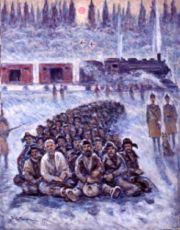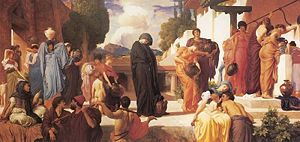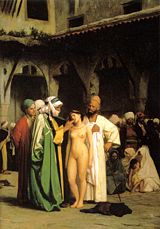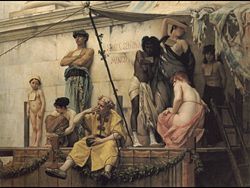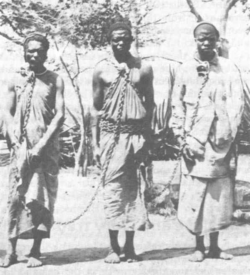Slavery
2008/9 Schools Wikipedia Selection. Related subjects: Animal & Human Rights; General history
Slavery is a social-economic system under which certain persons — known as slaves — are deprived of personal freedom and compelled to work.
Slaves are held against their will from the time of their capture, purchase, or birth, and are deprived of the right to leave, to refuse to work, or to receive compensation (such as wages) in return for their labor. As such, slavery is one form of unfree labor.
In its narrowest sense, the word slave refers to people who are treated as the property of another person, household, company, corporation or government. This is referred to as chattel slavery.
Current situation
Although outlawed in nearly all countries today, slavery is still practiced in some parts of the world. According to a broad definition of slavery used by Kevin Bales of Free the Slaves, an advocacy group linked with Anti-Slavery International, there are 27 million people (though some put the number as high as 200 million) in virtual slavery today, spread all over the world. This is, also according to that group:
- The largest number of people that has ever been in slavery at any point in world history.
- The smallest percentage of the total human population that has ever been enslaved at once.
- Reducing the price of slaves to as low as US$40 in Mali for young adult male laborers, to a high of US$1000 or so in Thailand for HIV-free young females suitable for use in brothels. This represents the price paid to the person, or parents.
- This represents the lowest price that there has ever been for a slave in raw labor terms — while the price of a comparable male slave in 1850 America would have been about US$1000 in the currency of the time (US$38,000 today), thus slaves, at least of that category, now cost one thirty-eighth of their price 150 years ago, although this does not refer to the price of an 1850 slave in Africa.
- As a result, the economics of slavery is stark: the yield of profit per year for those buying and controlling a slave is over 800% on average, as opposed to the 5% per year that would have been the expected payback for buying a slave in colonial times. This combines with the high potential to lose a slave (have them stolen, escape, or freed by unfriendly authorities) to yield what are called disposable people — those who can be exploited intensely for a short time and then discarded, such as the prostitutes thrown out on city streets to die once they contract HIV, or slaves forced to work in mines.
Although outlawed in most countries today slavery is, nonetheless, practiced in secret in many parts of the world — with outright enslavement still taking place in parts of Africa, the Middle East, and South Asia. In June and July 2007, 570 people who had been enslaved by brick manufacturers in Shanxi and Henan were freed by the Chinese government. Of those rescued, 69 of them were children. In response, the Chinese government assembled a force of 35,000 police to check northern Chinese brick kilns for slaves, sent dozens of kiln supervisors to prison, punished 95 officials in Shanxi province for dereliction of duty, and sentenced one kiln foreman to death for killing an enslaved worker.
In Mauritania alone, it is estimated that up to 600,000 men, women and children, or 20% of the population, are enslaved, many of them used as bonded labour. Slavery in Mauritania was criminalized in August 2007. In Niger, slavery is also a current phenomenon. A Nigerian study has found that more than 800,000 people are enslaved, almost 8% of the population. Child slavery has commonly been used in the production of cash crops and mining. According to the U.S. Department of State, more than 109,000 children were working on cocoa farms alone in Côte d'Ivoire (Ivory Coast) in 'the worst forms of child labor' in 2002.
Etymology
Prior to the 10th century, words other than "slave" were used for all kinds of unfree labourers. For instance, the old Latin word for "slave" was servus, which was used for both serfs and chattel slaves.
The word slave, in the English language, originates from the Middle English sclave, the Old French esclave, the Medieval Latin sclavus and ultimately from the early Greek sklabos (from sklabenoi) meaning "Slavic people". The term originally referred to various peoples from Eastern and Central Europe, as many slavic and other people from these areas were captured and sold as slaves by a Holy Roman Emperor, Otto I ( 912– 973), and his successors.
Definitions
The 1926 Slavery Convention described slavery as "...the status and/or condition of a person over whom any or all of the powers attaching to the right of ownership are exercised..." Slaves cannot leave an owner, an employer or a territory without explicit permission (they must have a passport to leave), and they will be returned if they escape. Therefore a system of slavery — as opposed to the isolated instances found in any society — requires official, legal recognition of ownership, or widespread tacit arrangements with local authorities, by masters who have some influence because of their social and/or economic status and their lives. The International Labour Organization (ILO) defines forced labour as "all work or service which is extracted from any person under the menace of any penalty and for which the said person has not offered himself voluntarily", albeit with certain exceptions of: military service, convicted criminals, emergencies and minor community services.
The current usage of the word serfdom is not usually synonymous with slavery, because medieval serfs were considered to have rights, as human beings, whereas slaves were considered “things” — property.
Slaves are people who are owned and controlled by others in a way that they have almost no rights or freedom of movement and are not paid for their labour, aside from food, clothing and shelter needed for basic subsistence.
Other uses of the term
- The International Labour Organization says that child labour usually amounts to forced labour.
- Many anarchists, socialists, and communists have condemned " wage slavery" or "economic slavery", where workers are forced to choose between accepting wages perceived as too low for their work and not being paid at all (and so presumably starving). This is related to the notion of economic coercion.
- Some libertarians and anarcho-capitalists view government taxation as a form of slavery
- Some feel that military drafts and other forms of coerced government labor constitute slavery. Gladiators, for example, were often slaves, with Spartacus being a famous example.
- Some proponents of animal rights apply the term slavery to the condition of some or all human-owned animals, arguing that their status is no different from that of human slaves.
- Some feel that child support orders amount to slavery . (Labor is compelled in typical court orders, and loss of employment often results in jail time for nonsupport.)
History
The evidence for slavery predates written records. It can be found in almost all cultures and continents. Slavery can be traced to the earliest records, such as the Code of Hammurabi in Mesopotamia (~1800 BC), which refers to slavery as an already established institution. An important exception occurred under the reign of the Achaemenid Empire in Persia in 500 BC. The forced labor of women in some ancient and modern cultures may also be identified as slavery. Slavery, in this case, includes sexual services.
Historically, most slaves were captured in wars or kidnapped in isolated raids, but some persons were sold into slavery by their parents, or by themselves, as a means of surviving extreme conditions. Most slaves were born into that status, to parents who were enslaved. Ancient Warfare often resulted in slavery for prisoners and their families, who were either killed, ransomed or sold as slaves. Captives were often considered the property of those who captured them and were looked upon as a prize of war. Slavery may originally have been more humane than simply executing those who would return to fight if they were freed, but the effect led to widespread enslavement of particular groups of people. Those captured sometimes differed in ethnicity, nationality, religion, or race from their enslavers, but often were the same as the captors. The dominant group in an area might take captives and turn them into slaves with little fear of suffering the like fate. The possibility always existed of reversals of fortune, as when Seneca warned, at the height of the Roman Empire, when powerful nations fought among themselves, anyone might find himself enslaved.
Brief sporadic raids or kidnapping could mean enslavement of persons otherwise not at war. St. Patrick recounted in his Confession having been kidnapped by pirates.
In ancient societies
Ancient societies characterized by poverty, rampant warfare or lawlessness, famines, population pressures, and cultural and technological lag are frequently exporters of slaves to more developed nations. Today the illegal slave trade (mostly in Africa) deals with slaves who are rural people forced to move to cities, or those purchased in rural areas and sold into slavery in cities. These moves take place due to loss of subsistence agriculture, thefts of land, and population increases.
In many ancient cultures, persons (often including their family) convicted of serious crimes could be sold into slavery. The proceeds from this sale were often used to compensate the victims. The Code of Hammurabi (~1800 BC) prescribes this for failure to maintain a water dam, to compensate victims of a flood. The convicted criminal might be sold into slavery if he lacked the property to make compensation to the victims. Other laws and other crimes might enslave the criminal regardless of his property. Some laws called for the criminal and all his property to be handed over to his victim.
Child slavery
People have been sold into slavery so that the money could be used to pay off their debts. This could range from a judge, king or Emperor ordering a debtor sold with all his family, to the poor selling off their own children to prevent starvation. In times of dire need such as famine, people have offered themselves into slavery not for a purchase price, but merely so that their new master would feed and take care of them.
In most institutions of slavery throughout the world, the children of slaves became the property of the master. Local laws varied as to whether the status of the mother or of the father determined the fate of the child, but it was usually determined by the status of the mother. In many cultures, slaves could earn their freedom through hard work and buying their own freedom. This was not possible in all cultures.
According to the Anti-Slavery Society, "Although there is no longer any state which legally recognizes, or which will enforce, a claim by a person to a right of property over another, the abolition of slavery does not mean that it ceased to exist. There are millions of people throughout the world — mainly children — in conditions of virtual slavery, as well as in various forms of servitude which are in many respects similar to slavery." It further notes that slavery, particularly child slavery, was on the rise in 2003. It points out that there are countless others in other forms of servitude (such as peonage, bonded labor and servile concubinage) which are not slavery in the narrow legal sense. Critics claim they are stretching the definition and practice of slavery beyond its original meaning, and are actually referring to forms of unfree labour other than slavery.
Slave work
The type of work slaves did depended on the time period and location of their slavery. In general, they did the same work as everyone else in the lower echelons of the society they lived in but were not paid for it beyond room and board, clothing etc. The most common types of slave work are domestic service, agriculture, mineral extraction, army make-up, industry, and commerce. Prior to about the 18th century, domestic services were acquired in some wealthier households and may include up to four female slaves and their children on its staff. The chattels (as they are called in some countries) are expected to cook, clean, sometimes carry water from an outdoor pump into the house, and grind cereal. Most hired servants to do the same tasks.
Many slaves were used in agriculture and cultivation from ancient times through the 1800s. The strong, young men and women were sometimes forced to work long days in the fields, with little or no breaks for water or food. Since slaves were usually considered valuable property, they were usually taken care of in the sense that minimally adequate food and shelter were provided to maintain good health, and that the workload was not excessive to the point of endangering health. However, this was not always the case in many countries where they worked on land that was owned by absentee owners. The overseers in many of these areas literally worked the slaves to death.
In mineral extraction, the majority of the work, when done by slaves, was done nearly always by men. In some places, they mined the salt that was used during extensive trade in the 19th century.
Some of the men in ancient civilizations who were bought into chattel slavery were trained to fight in their nation's army and other military services. Chattel slaves were occasionally trained in artisan workshops for industry and commerce. The men worked in metalworking, while the females normally worked in either textile trades or domestic household tasks. The majority of the time, the slave owners did not pay the chattels for their services beyond room and board, clothing etc.
However, not all slaves were manual laborers or servants. In some societies slaves sometimes attained highly responsible positions. In the Bible, Joseph, for instance, was sold into slavery in Egypt by his brothers, who were jealous of his vanity (and his many-colored coat), but rose to become vizier to the Pharaoh. And the ranks of the Mamelukes, who ruled Egypt until being defeated by Napolean in 1798, were filled by slaves from the Caucasus who were allowed to rule Egypt in exchange for maintaining its military defense.
Female slavery
Female slaves were long traded to the Middle Eastern countries and kingdoms by Arab traders and sold into sexual slavery to work as concubines or prostitutes. Typically, females were sold at a lower price than their male counterparts, with one exception being when (predominantly) Irish women captured in Viking raids were sold to the Middle East in the 800-1200 period.

Western slavery
In the West, slavery ended during the Medieval period, only to be revived after the Renaissance and its appreciation of the organization of classical society (i.e. ancient Greece and Rome).
Human trafficking
Trafficking in human beings, sometimes called human trafficking, or sex trafficking (as the majority of victims are women or children forced into prostitution), is not the same as people smuggling. A smuggler will facilitate illegal entry into a country for a fee, but on arrival at their destination, the smuggled person is free; the trafficking victim is enslaved. Victims do not agree to be trafficked: they are tricked, lured by false promises, or forced into it. Traffickers use coercive tactics including deception, fraud, intimidation, isolation, threat and use of physical force, debt bondage or even force-feeding with drugs of abuse to control their victims. Whilst the majority of victims are women, and sometimes children, forced into prostitution, other victims include men, women and children forced into manual labour. Due to the illegal nature of trafficking, the exact extent is unknown. A US Government report published in 2003, estimates that 800,000-900,000 people worldwide are trafficked across borders each year. This figure does not include those who are trafficked internally.
Economics
Economists have attempted to model during which circumstances slavery (and milder variants such as serfdom) appear and disappear. One observation is that slavery becomes more desirable for land owners when land is abundant but labour is not, so paid workers can demand high wages. If labour is abundant but land is scarce, then it becomes more costly for the land owners to have guards for the slaves than to employ paid workers who can only demand low wages due to the competition. Thus first slavery and then serfdom gradually decreased in Europe as the population grew. It was reintroduced in the Americas and in Russia (serfdom) as large new land areas with few people become available.
Another observation is slavery is more common when the labour done is relatively simple and thus easy to supervise, such as large scale growing of a single crop. It is much more difficult and costly to check that slaves are doing their best and with good quality when they are doing complex tasks. Thus, slavery tends to decrease with technological advancements requiring more skilled people, even as they are able to demand high wages. Because of this, theoretical knowledge and learning in Greece—and later in Rome—was largely separated from physical labour and manufacturing.
It has also been argued that slavery tends to retard technological advancement, since the focus is on increasing the number of slaves rather than improving the efficiency of labor. Some Russian scholars have argued that the Soviet Union's technological development was hindered by Stalin's use of slave labor.
Contemporary slavery
Since 1945, debate about the link between economic growth and different relational forms (most notably unfree social relations of production in Third World agriculture) occupied many contributing to discussions in the development decade (the 1960s). This continued to be the case in the mode of production debate (mainly about agrarian transition in India) that spilled over into the 1970s, important aspects of which continue into the present (see the monograph by Brass, 1999, and the 600 page volume edited by Brass and van der Linden, 1997). Central to these discussions was the link between capitalist development and modern forms of unfree labour ( peonage, debt bondage, indenture, chattel slavery). Within the domain of political economy it is a debate that has a very long historical lineage, and - accurately presented - never actually went away. Unlike advocacy groups, for which the number of the currently unfree is paramount, those political economists who participated in the earlier debates sought to establish who, precisely, was (or was not) to be included under the rubric of a worker whose subordination constituted a modern form of unfreedom. This element of definition was regarded as an epistemologically necessary precondition to any calculations of how many were to be categorized as relationally unfree.
There are three general types of slavery today: wage slaves, contract slaves, and slaves in the traditional sense.
- Wage slavery often occurs in underdeveloped areas, where employers can afford to employ people at low wages, knowing they can't afford to risk their employment. Most child laborers for example, can be considered to be wage slaves. Marxists and anarchists, however, use the term more broadly to refer to a situation in which a person must sell his or her labor power, submitting to the authority of an employer in order to prosper or merely to subsist; creating a hierarchical social condition in which a person chooses a job but only within a coerced set of choices (e.g. work for a boss or starve) which usually excludes democratic worker's control of the workplace and the economy as a whole and unconditional access to food, shelter and health care.
- Contract slaves are generally poor, often illiterate, people who have been tricked into signing contracts they do not understand.
- Slavery in its traditional sense is still very active; only its activities are carried out underground. Actual slavery is still carried out much the same way it has been for centuries: people, often women and children, are abducted (usually from underdeveloped countries such as those in the Middle East, South America, Asia, Africa and the former Soviet Bloc countries), loaded aboard a ship and smuggled to a foreign country (usually Asia or the Middle East) and they are sold, the men and male children sold for labor, while the women and girls for domestic slavery or to work as unwilling prostitutes primarily in Asia and the West.
A combination of wage and contract slavery is found in Sarawak mining towns among Indonesian Dayak immigrants looking for work. They have to buy the tools they need to work with, but often don't have the required money, so they need to buy them on a loan. Then they discover that local food is so expensive that all their wages are spent on that, so they can't pay off the loan and are forced by law to keep working for no gain.
Slavery still exists today all across the world. Groups such as the American Anti-Slavery Group, Anti-Slavery International and Free the Slaves, the Anti-Slavery Society, and the Norwegian Anti-Slavery Society continue to campaign to rid the world of slavery.
On December 10, 1948, the General Assembly of the United Nations adopted the Universal Declaration of Human Rights. Article 4 states:
- No one shall be held in slavery or servitude; slavery and the slave trade shall be prohibited in all their forms.
Since 1997, the United States Department of Justice has, through work with the Coalition of Immokalee Workers, prosecuted six individuals on charges of slavery in the agricultural industry. These prosecutions have led to freedom for over 1000 slaves in the tomato and orange fields of South Florida.
This is only one example of the contemporary fight against slavery worldwide, which is especially pervasive in agriculture, apparel and the sex industry.
In the contemporary United States, the mantle of "abolitionist" has been widely embraced by those who seek to abolish the death penalty, those advocating immigration rights, and anarchists seeking to abolish the state.
Abolitionist movements
History of abolitionism
Slavery has existed, in one form or another, through the whole of recorded human history — as have, in various periods, movements to free large or distinct groups of slaves. According to the Biblical Book of Exodus, Moses led Israelite slaves out of ancient Egypt — possibly the first written account of a movement to free slaves. Later Jewish laws (known as Halacha) prevented slaves from being sold out of the Land of Israel, and allowed a slave to move to Israel if he so desired. The Cyrus Cylinder, inscribed about 539 BC by the order of Cyrus the Great of Persia, abolished slavery and allowed Jews and other nationalities who had been enslaved under Babylonian rule to return to their native lands. Abolitionism should be distinguished from efforts to help a particular group of slaves, or to restrict one practice, such as the slave trade.
There were celebrations in 2007 to commemorate the 200th anniversary of the Abolition of the slave trade in the United Kingdom. William Wilberforce received much of the credit although the groundwork was an anti-slavery essay by Thomas Clarkson. Wilberforce was also urged by his close friend, Prime Minister William Pitt, to make the issue his own. After the abolition act was passed these campaigners switched to encouraging other countries to follow suit, notably France.
Abolitionist pressure in the United States produced a series of small steps forward. After January 1, 1808, the importation of slaves into the United States was prohibited, but not the internal slave trade, nor involvement in the international slave trade externally. Legal slavery persisted; and those slaves already in the U.S. would not be legally emancipated for another 60 years.
Apologies
On May 21, 2001, the National Assembly of France passed the Taubira law, recognizing slavery as a crime against humanity. At the same time the British, Spanish, Dutch and Portuguese delegations declined to give an apology for the slave trade and limited to give a "regret." This is probably due to the legal implications of such a statement. It is worth to mention that it is uncertain whether the apology of these four nations are for "slave trade" or "slavery". Apologies on behalf of African nations, for their role in trading their countrymen into slavery, also remain an open issue since slavery was practiced in Africa even before the first Europeans arrived and the Atlantic slave trade was performed with a high degree of involvement of several African societies. The black slave market was supplied by well-established slave trade networks controlled by local African societies and individuals. Indeed, as already mentioned in this article, slavery persists in several areas of West Africa until the present day.
"There is adequate evidence citing case after case of African control of segments of the trade. Several African nations such as the Ashanti of Ghana and the Yoruba of Nigeria had economies depended solely on the trade. African peoples such as the Imbangala of Angola and the Nyamwezi of Tanzania would serve as middlemen or roving bands warring with other African nations to capture Africans for Europeans."
Several historians have made important contributions to the global understanding of the African side of the Atlantic slave trade. By arguing that African merchants determined the assemblage of trade goods accepted in exchange for slaves, many historians argue for African agency and ultimately a shared responsibility for the slave trade.
The issue of an apology is linked to reparations for slavery and is still being pursued by a number of entities across the world. For example, the Jamaican Reparations Movement approved its declaration and action Plan.
In September, 2006, it was reported that the UK Government may issue a "statement of regret" over slavery, an act that was followed through by a "public statement of sorrow" from Tony Blair on November 27, 2006.
On February 25, 2007 the state of Virginia resolved to 'profoundly regret' and apologize for its role in the institution of slavery. Unique and the first of its kind in the U.S., the apology was unanimously passed in both Houses as Virginia approached the 400th anniversary of the founding of Jamestown, where the first slaves were imported into North America in 1619.
On August 24, 2007, Mayor Ken Livingstone of London, England apologized publicly for Britain's role in colonial slave trade. "You can look across there to see the institutions that still have the benefit of the wealth they created from slavery," he said pointing towards the financial district. He claimed that London was still tainted by the horrors of slavery. Jesse Jackson praised Mayor Livingstone, and added that reparations should be made.
Reparations
Sporadically there have been movements to achieve reparations for those formerly held as slaves, or sometimes their descendants. Claims for reparations for being held in slavery are handled as a civil law matter in almost every country. This is often decried as a serious problem, since former slaves' relative lack of money means they often have limited access to a potentially expensive and futile legal process. Mandatory systems of fines and reparations paid to an as yet undetermined group of claimants from fines, paid by unspecified parties, and collected by authorities have been proposed by advocates to alleviate this "civil court problem". Since in almost all cases there are no living ex-slaves or living ex-slave owners these movements have gained little traction. In nearly all cases the judicial system has ruled that the statute of limitations on these possible claims has long since expired.
Nonetheless, from time to time information is circulated (often through e-mail) to United States residents describing a $5000 "slavery tax credit", passed into law under President Bill Clinton's administration during the 1990s, but never announced to the public. No such credit exists, and persons attempting to promote or take advantage of the alleged credit are subject to prosecution. (See Slavery reparations scam for further information.) A similar scam involves a "tax credit" available to Native Americans.
Religion and slavery
Some argue that the Bible condones slavery in Ancient Israelite society by failing to condemn the widespread existing practice present in other cultures. It also explicitly states that under certain circumstances, slavery is morally acceptable. Nonetheless the Bible was used, before and during the American Civil War, by both slaveholders and abolitionists to justify their views. A significant theme in the Bible is deliverance from slavery, as in the Exodus story and in the sense of deliverance from sin. A familiar quotation from the Christian Bible appears in both Isaiah 61:1-2 and Luke 4:17-19:
And there was delivered unto him the book of the prophet Isaiah. And when he [Jesus] had opened the book, he found the place where it was written, "The Spirit of the Lord is upon me, because he hath anointed me to preach the gospel to the poor; he hath sent me to heal the brokenhearted, to preach deliverance to the captives, and recovering of sight to the blind, to set at liberty them that are bruised, to preach the acceptable year of the Lord."


